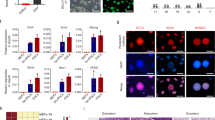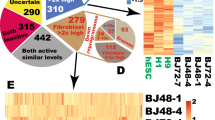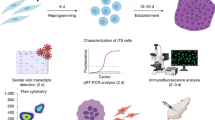Abstract
Somatic cells can be reprogrammed into induced pluripotent stem (iPS) cells by the transcription factors Oct4, Sox2, and Klf4 in combination with c-Myc. Recently, Sox2 plus Oct4 was shown to reprogram fibroblasts and Oct4 alone was able to reprogram mouse and human neural stem cells (NSCs) into iPS cells. Here, we report that Bmi1 leads to the transdifferentiation of mouse fibroblasts into NSC-like cells, and, in combination with Oct4, can replace Sox2, Klf4 and c-Myc during the reprogramming of fibroblasts into iPS cells. Furthermore, activation of sonic hedgehog signaling (by Shh, purmorphamine, or oxysterol) compensates for the effects of Bmi1, and, in combination with Oct4, reprograms mouse embryonic and adult fibroblasts into iPS cells. One- and two-factor iPS cells are similar to mouse embryonic stem cells in their global gene expression profile, epigenetic status, and in vitro and in vivo differentiation into all three germ layers, as well as teratoma formation and germline transmission in vivo. These data support that converting fibroblasts with Bmi1 or activation of the sonic hedgehog pathway to an intermediate cell type that expresses Sox2, Klf4, and N-Myc allows iPS generation via the addition of Oct4.
Similar content being viewed by others
Log in or create a free account to read this content
Gain free access to this article, as well as selected content from this journal and more on nature.com
or
References
Hong H, Takahashi K, Ichisaka T, et al. Suppression of induced pluripotent stem cell generation by the p53-p21 pathway. Nature 2009; 460:1132–1135.
Kawamura T, Suzuki J, Wang YV, et al. Linking the p53 tumour suppressor pathway to somatic cell reprogramming. Nature 2009; 460:1140–1144.
Li H, Collado M, Villasante A, et al. The Ink4/Arf locus is a barrier for iPS cell reprogramming. Nature 2009; 460:1136–1139.
Marion RM, Strati K, Li H, et al. A p53-mediated DNA damage response limits reprogramming to ensure iPS cell genomic integrity. Nature 2009; 460:1149–1153.
Pei D . Regulation of pluripotency and reprogramming by transcription factors. J Biol Chem 2009; 284:3365–3369.
Utikal J, Polo JM, Stadtfeld M, et al. Immortalization eliminates a roadblock during cellular reprogramming into iPS cells. Nature 2009; 460:1145–1148.
Haupt Y, Alexander WS, Barri G, Klinken SP, Adams JM . Novel zinc finger gene implicated as myc collaborator by retrovirally accelerated lymphomagenesis in E mu-myc transgenic mice. Cell 1991; 65:753–763.
van Lohuizen M, Verbeek S, Scheijen B, Wientjens E, van der Gulden H, Berns A . Identification of cooperating oncogenes in E mu-myc transgenic mice by provirus tagging. Cell 1991; 65:737–752.
Jacobs JJ, Kieboom K, Marino S, DePinho RA, van Lohuizen M . The oncogene and Polycomb-group gene bmi-1 regulates cell proliferation and senescence through the ink4a locus. Nature 1999; 397:164–168.
Jacobs JJ, Scheijen B, Voncken JW, Kieboom K, Berns A, van Lohuizen M . Bmi-1 collaborates with c-Myc in tumorigenesis by inhibiting c-Myc-induced apoptosis via INK4a/ARF. Genes Dev 1999; 13:2678–2690.
Molofsky AV, Pardal R, Iwashita T, Park IK, Clarke MF, Morrison SJ . Bmi-1 dependence distinguishes neural stem cell self-renewal from progenitor proliferation. Nature 2003; 425:962–967.
Park IK, Qian D, Kiel M, et al. Bmi-1 is required for maintenance of adult self-renewing haematopoietic stem cells. Nature 2003; 423:302–305.
Valk-Lingbeek ME, Bruggeman SW, van Lohuizen M . Stem cells and cancer; the polycomb connection. Cell 2004; 118:409–418.
Hatton BA, Knoepfler PS, Kenney AM, et al. N-myc is an essential downstream effector of Shh signaling during both normal and neoplastic cerebellar growth. Cancer Res 2006; 66:8655–8661.
Leung C, Lingbeek M, Shakhova O, et al. Bmi1 is essential for cerebellar development and is overexpressed in human medulloblastomas. Nature 2004; 428:337–341.
Moon JH, Yoon BS, Kim B, et al. Induction of neural stem cell-like cells (NSCLCs) from mouse astrocytes by Bmi1. Biochem Biophys Res Commun 2008; 371:267–272.
Kim JB, Sebastiano V, Wu G, et al. Oct4-induced pluripotency in adult neural stem cells. Cell 2009; 136:411–419.
Kim JB, Greber B, Arauzo-Bravo MJ, et al. Direct reprogramming of human neural stem cells by OCT4. Nature 2009; 461:649–643.
Huangfu D, Osafune K, Maehr R, et al. Induction of pluripotent stem cells from primary human fibroblasts with only Oct4 and Sox2. Nat Biotechnol 2008; 26:1269–1275.
Dahmane N, Ruiz i Altaba A . Sonic hedgehog regulates the growth and patterning of the cerebellum. Development 1999; 126:3089–3100.
Wechsler-Reya RJ, Scott MP . Control of neuronal precursor proliferation in the cerebellum by Sonic Hedgehog. Neuron 1999; 22:103–114.
Corcoran RB, Scott MP . Oxysterols stimulate Sonic hedgehog signal transduction and proliferation of medulloblastoma cells. Proc Natl Acad Sci USA 2006; 103:8408–8413.
Lipinski RJ, Gipp JJ, Zhang J, Doles JD, Bushman W . Unique and complimentary activities of the Gli transcription factors in Hedgehog signaling. Exp Cell Res 2006; 312:1925–1938.
Takahashi K, Yamanaka S . Induction of pluripotent stem cells from mouse embryonic and adult fibroblast cultures by defined factors. Cell 2006; 126:663–676.
Chen J, Liu J, Yang J, et al. BMPs functionally replace Klf4 and support efficient reprogramming of mouse fibroblasts by Oct4 alone. Cell Res 2011; 21:205–212.
Li Y, Zhang Q, Yin X, et al. Generation of iPSCs from mouse fibroblasts with a single gene, Oct4, and small molecules. Cell Res 2011; 21:196–204.
Yuan X, Wan H, Zhao X, Zhu S, Zhou Q, Ding S . Combined chemical treatment enables Oct4-induced reprogramming from mouse embryonic fibroblasts. Stem Cells 2011; 29:549–553.
Shao L, Feng W, Sun Y et al. Generation of iPS cells using defined factors linked via the self-cleaving 2A sequences in a single open reading frame. Cell Res 2009; 19:296–306.
Acknowledgements
We are grateful to Drs Goberdhan P Dimri (NorthShore University HealthSystem Research Institute, USA)and Gou Young Koh (Korea Advanced Institute of Science and Technology, Republic of Korea) for kindly providing the pBabe-Bmi1, pMX-Oct4, pMX-Sox2, pMX-Klf4, and pMX-C-Myc constructs. We thank Jihyun Kim, Jihye Hwang, and Suhyun Kwon for technical support. This research was supported by a grant (SC-5150) from the Stem Cell Research Center of the 21st Century Frontier Research Program funded by the Ministry of Education, Science and Technology, Republic of Korea, a grant (09172KFDA653) from the Korea Food and Drug Administration, and a grant (2010-0020347) from National Research Foundation (NRF) funded by the Korea government (MEST). Work in Germany was supported by the Max Planck Society and the Federal Ministry of Education and Research (BMBF) on Cell-Based Regenerative Medicine (Grant 01GN0539).
Author information
Authors and Affiliations
Corresponding authors
Additional information
( Supplementary information is linked to the online version of the paper on the Cell Research website.)
Supplementary information
Supplementary information, Figure S1
Phase-contrast photographs of cell morphology and immunofluoresence of reprogrammed iPS cells. (PDF 176 kb)
Supplementary information, Figure S2
Characterization of BO-iPS cells. (PDF 135 kb)
Supplementary information, Figure S3
Generation and characterization of BO-iPS clones (1–6) from established BO-iPS cells by single cell culture. (PDF 189 kb)
Supplementary information, Figure S4
Characterization of ShO-iPS generated from MEFs by treatment of Shh and retroviral transduction with Oct4. (PDF 157 kb)
Supplementary information, Figure S5
Generation and characterization of PO-iPS cells and OxyO-iPS cells. (PDF 222 kb)
Supplementary information, Figure S6
Generation and characterization of 1F PO-iPS cells. (PDF 203 kb)
Supplementary information, Figure S7
Generation and characterization of 1F OxyO-iPS-TTF cells. (PDF 189 kb)
Supplementary information, Figure S8
Global gene expression analyses by DNA microarray (PDF 113 kb)
Supplementary information, Figure S9
Karyotype analysis of iPS cells. (PDF 105 kb)
Supplementary information, Table S1
Population doubling time (PDF 35 kb)
Supplementary information, Table S2
Genes belonging to groups in Supplementary information, Figure S8 (PDF 99 kb)
Supplementary information, Table S3
Primers used in this study (PDF 134 kb)
Supplementary information, Data S1
Supplemental Methods (PDF 63 kb)
Supplementary information, Table S4
Antibodies and dilutions used in this study (PDF 48 kb)
Rights and permissions
About this article
Cite this article
Moon, JH., Heo, J., Kim, J. et al. Reprogramming fibroblasts into induced pluripotent stem cells with Bmi1. Cell Res 21, 1305–1315 (2011). https://doi.org/10.1038/cr.2011.107
Received:
Revised:
Accepted:
Published:
Issue date:
DOI: https://doi.org/10.1038/cr.2011.107
Keywords
This article is cited by
-
1′-O-methyl-averantin isolated from the endolichenic fungus Jackrogersella sp. EL001672 suppresses colorectal cancer stemness via sonic Hedgehog and Notch signaling
Scientific Reports (2023)
-
OCT4-induced oligodendrocyte progenitor cells promote remyelination and ameliorate disease
npj Regenerative Medicine (2022)
-
The therapeutic potential of induced hepatocyte-like cells generated by direct reprogramming on hepatic fibrosis
Stem Cell Research & Therapy (2019)
-
An Insight into DNA-free Reprogramming Approaches to Generate Integration-free Induced Pluripotent Stem Cells for Prospective Biomedical Applications
Stem Cell Reviews and Reports (2019)
-
Validation of Common Housekeeping Genes as Reference for qPCR Gene Expression Analysis During iPS Reprogramming Process
Scientific Reports (2018)



